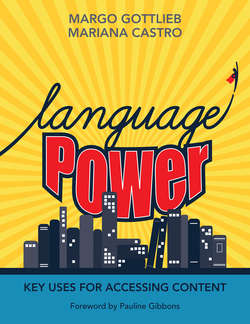Читать книгу Language Power - Margo Gottlieb - Страница 6
На сайте Литреса книга снята с продажи.
List of Resources
ОглавлениеResource P.1 Reasons for Promoting Academic Conversations in School 14
Resource 1.1 Factors Impacting Language Use in Academic Contexts 43
Resource 1.2 Monitoring Language Use During Group Discussions 44
Resource 1.3 Resources for Promoting Discussions 45
Resource 1.4 Language Use in Argument: Primary Grades 46
Resource 1.5 Language Use in Argument: Intermediate Grades 47
Resource 1.6 Accessing Multiple Modalities to Express an Argument 48
Resource 1.7 Creating Recounts From Original Sources 48
Resource 1.8 Language Use in Narratives: Primary Grades 49
Resource 1.9 Language Use in Narrative Recounts: Intermediate Grades 50
Resource 1.10 Language Use in Informational Recounts: Primary Grades 51
Resource 1.11 Language Use in Informational Texts: Intermediate Grades 52
Resource 1.12 Language Use in Explanations 53
Resource 1.13 Documenting Features of Explanations 54
Resource 1.14 Recording and Monitoring Language Use Throughout the School Year 55
Resource 2.1 Identifying Key Uses of Academic Language in Content Standards and Language Standards 86
Resource 2.2 Identifying Key Uses of Academic Language in Disciplinary Practices 87
Resource 2.3 Aligning Language Foci With Academic Content Standards and Disciplinary Practices 88
Resource 2.4 A Needs Assessment for Teachers of 21st Century Classrooms 89
Resource 2.5 Identifying 21st Century Skills and Standards in Your Curriculum Plan 90
Resource 2.6 A Needs Assessment for Teachers and School Leaders of 21st Century Classrooms: School or District Level 91
Resource 2.7 Representing Curriculum Through Multimodal Approaches to Learning 93
Resource 2.8 Key Uses of Academic Language in Curriculum 94
Resource 2.9 Connecting DARE to Cognitive Functions 95
Resource 2.10 Representation of Key Uses of Academic Language in Curricular Resources 96
Resource 2.11 Key Uses in Curricular Activities and Instructional Materials 97
Resource 3.1 A Generic Rubric for Measuring DARE Across the Content Areas for Oral and Written Language 132
Resource 3.2 A Planning Sheet for Instructional Assessment of Key Uses of Academic Language 133
Resource 3.3 Exemplifying Key Uses of Academic Language Through Blogging 134
Resource 3.4 Gaining Metalinguistic Awareness Through Blogs 135
Resource 3.5 Student Self-Assessment for Participating in Discussions: A Checklist for Grades 3–5 136
Resource 3.6 Student Self-Assessment for Participating in Discussions: A Checklist for Grades 5–8 137
Resource 3.7 A Peer Assessment Checklist for Debates or Persuasive Speeches 138
Resource 3.8 A Blog About the Death of Michael Jackson 139
Resource 3.9 Documenting Metalinguistic Awareness 140
Resource 3.10 A Checklist to Apprentice Students Into Math Discourse Through Key Uses of Academic Language 141
Resource 3.11 The Language of Mathematics: Expressions of Key Uses of Academic Language 142
Resource 3.12 An Assessment Checklist for ELLs and Other Language Learners Based on DARE for Scientific Investigation 143
Resource 3.13 Documenting Key Uses of Academic Language for Science Themes 144
Resource 3.14 A Sample Scenario for an Explanation Chart for Classes 145
Resource 3.15 A Summary Chart of Key Uses of Academic Language: Ideas for Instructional Assessment Across the Content Areas 146
Resource 4.1 Signs of Student Agency in Teaching and Learning 178
Resource 4.2 A Checklist of Classroom Strategies That Promote Student Agency 179
Resource 4.3 Moving From Dependence on Others to Independence: A Continuum of Student Change of Classroom Roles 180
Resource 4.4 Creating the Opportunity to Learn Through Student Engagement 181
Resource 4.5 Building Student Participation Around DARE in the Teaching and Learning Cycle 182
Resource 4.6 Evidence of Key Uses in Instructional Materials 183
Resource 4.7 Representation of the Principles of Universal Design for Learning in Instructional Materials 184
Resource 4.8 Strategies for Engaging Students in Key Uses of Academic Language Inclusive of Multiple Learning Styles and Materials 185
Resource 4.9 Instructional Materials Rating Scale 186
Resource 4.10 Recount Based on a Movie or Video 187
Resource 4.11 An Example of Argue Based on Informational Text 188
Resource 4.12 Explain Using Real-Life Objects and Materials 189
Resource 4.13 Revisiting Instructional Materials Through the Lens of Linguistic and Cultural Sustainability 190
Resource 4.14 Examples of Key Uses of Academic Language for Scaffolding Instruction 191
Resource 4.15 A Checklist Rating Scale for Scaffolding Instruction and Assessment Inclusive of Language and Content 192
Resource 4.16 Applying Key Uses to Student Think-Aloud Strategies for Literature 193
Resource 4.17 Thinking About Language Use in Student Conversations: A Self-Assessment Checklist 194
Resource 4.18 Visibility of Key Uses of Academic Language in English and Spanish 195
Resource 5.1 Students Making Their Own Semantic Maps 233
Resource 5.2 Students Responding to “I Can” Statements Related to English Language Arts Standards and Language Development Standards 234
Resource 5.3 Extending “I Can” Statements to a Rating Scale for Middle School 235
Resource 5.4 An Example of Student and Teacher Coconstruction of an Analytic Rubric for Arguments in Middle School 236
Resource 5.5 A Template for Designing Analytic Rubrics for Key Uses of Academic Language 237
Resource 5.6 A Family Interview 238
Resource 5.6 Entrevista con la Familia 239
Resource 5.7 Community Language Resources 240
Resource 5.8 Ideas for Encouraging Family Members to Participate in Language-Rich Activities 241
Resource 5.9 Planning for Extending the Engagement of Families 242
Resource 5.10 Formulating, Asking, and Answering Questions 243
Resource 5.11 Extending Conceptual Learning With Families and Students 244
Resource 5.12 Teacher Ideas for Student Choice 245
Resource 5.13 Teachers Collaborating With Other Teachers and Students: Using the Frayer Model to Promote Exploration of Key Uses of Academic Language 246
Resource 5.14 The Inclusion of Language Policy in the Mission and Vision of School 247
Resource 5.15 School Leaders Forging the Can-Do School Spirit: Evaluating Linguistic and Culturally Sustainable Schools 249
